
Edinburgh is the capital city of Scotland and one of its 32 council areas. Historically part of the county of Midlothian, it is located in Lothian on the southern shore of the Firth of Forth. Edinburgh is Scotland's second-most populous city and the seventh-most populous city in the United Kingdom.

Henry Dundas, 1st Viscount Melville, PC, FRSE, styled as Lord Melville from 1802, was a Scottish advocate and independent Whig politician. He was the trusted lieutenant of British Prime Minister William Pitt and the most powerful politician in Scotland in the late 18th century.

Glasgow Queen Street is a passenger railway terminus serving the city centre of Glasgow, Scotland. It is the smaller of the city's two mainline railway terminals and is the third busiest station in Scotland behind Central and Edinburgh Waverley.

Edinburgh Trams is a tramway in Edinburgh, Scotland, operated by Edinburgh Trams Ltd. As of 2017 it is a 14-kilometre (8.7 mi) line between York Place in the New Town and Edinburgh Airport, with 16 stops.
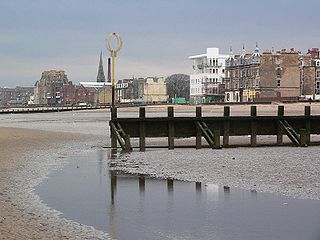
Portobello is a coastal suburb of Edinburgh in eastern central Scotland. It lies 3 miles (5 km) east of the city centre, facing the Firth of Forth, between the suburbs of Joppa and Craigentinny. Although historically it was a town in its own right, it is officially a residential suburb of Edinburgh. The promenade fronts onto a wide sandy beach.

Stewart's Melville College (SMC) is an independent day and boarding school in Edinburgh, Scotland. Classes are all boys in the 1st to 5th years and co-educational in Sixth (final) year. It has a roll of about 750 pupils.
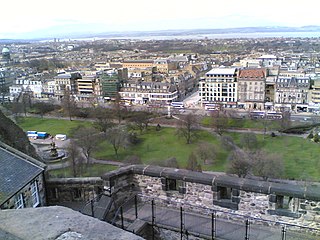
The New Town is a central area of Edinburgh, the capital of Scotland. It was built in stages between 1767 and around 1850, and retains much of its original neo-classical and Georgian period architecture. Its best known street is Princes Street, facing Edinburgh Castle and the Old Town across the geological depression of the former Nor Loch. Together with the Old Town, and West End, the New Town was designated a UNESCO World Heritage Site in 1995. The area is also famed for the New Town Gardens, a heritage designation since March 2001.

St Andrew's and St George's West Church serves Edinburgh's New Town, in Scotland. It is a congregation of the Church of Scotland. The parish today constitutes the whole of the First New Town of Edinburgh and a small part of the early-19th-century Second New Town of Edinburgh. The church building was completed in 1784, and is now protected as a category A listed building.

Edinburgh is a major transport hub in east central Scotland and is at the centre of a multi-modal transport network with road, rail and air communications connecting the city with the rest of Scotland and internationally.

St Andrew Square is a garden square in Edinburgh, Scotland located at the east end of George Street. The gardens, part of the collection of New Town Gardens, are owned by a number of private owners, managed by Essential Edinburgh and opened to the public in 2008. The construction of St Andrew Square began in 1772, as the first part of the New Town, designed by James Craig. Within six years of its completion St Andrew Square became one of the most desirable and most fashionable residential areas in the city. As the 19th century came to a close, St Andrew Square evolved into the commercial centre of the city.
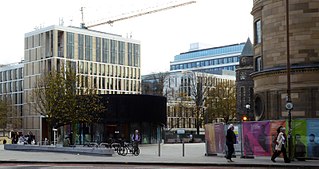
Bristo Square, Edinburgh, Scotland, is a public space on the estate of the University of Edinburgh. It lies in the south of the city, between George IV Bridge and George Square.

Dundas House is a Neoclassical building in Edinburgh, Scotland. It is located at 36 St Andrew Square, in the city's first New Town. The building was completed in 1774 as a private town house for Sir Lawrence Dundas by the architect Sir William Chambers. Much altered internally and extended over the years, today it is the registered office of the Royal Bank of Scotland and its parent, NatWest Group and is protected as a category A listed building.

Occupy Edinburgh was a protest against economic and social inequality as part of the global Occupy movement. The "occupation" began with the erection of a number of tents in St. Andrew Square on 14 October 2011.
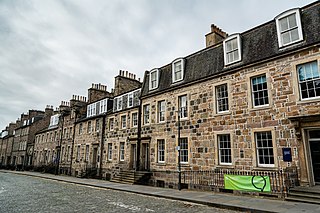
George Square is a city square in Edinburgh, Scotland. It is in the south of the city centre, adjacent to the Meadows. It was laid out in 1766 outside the overcrowded Old Town, and was a popular residential area for Edinburgh's better-off citizens. In the 1960s, much of the square was redeveloped by the University of Edinburgh, although the Cockburn Association and the Georgian Group of Edinburgh protested. Most but not all buildings on the square now belong to the university. Principal buildings include the Gordon Aikman Lecture Theatre, Edinburgh University Library, 40 George Square and Appleton Tower.

George Street is the central thoroughfare of the First New Town of Edinburgh, planned in the 18th century by James Craig.
Edinburgh World Heritage (EWH) is an independent charity in Edinburgh, Scotland established in 1999. It is tasked with conserving, enhancing and promoting Edinburgh's World Heritage Site "Old and New Towns of Edinburgh", which was designated in 1995. It was created through donations from the City of Edinburgh Council and Historic Scotland. The EWH has worked on over 1,500 projects across Edinburgh in the areas of conservation, learning, and planning. Some of these projects include restoring Edinburgh's historic graveyards, original street lighting, and monuments.

The following outline is provided as an overview of and topical guide to Edinburgh:
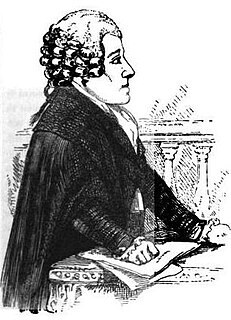
The Dundas Riots were a series of riots in Edinburgh over three consecutive days in June 1792. They are sometimes also called the King's Birthday Riots.
The Dunard Centre is a planned concert hall to be located in the city centre of Edinburgh, the capital of Scotland. The proposed venue is currently being designed by David Chipperfield Architects, with a variation to the existing planning application scheduled for 2021. The Dunard Centre is being designed to be a world-class venue with the very best in modern acoustics and will be a venue for all kinds of music and performance: from orchestral to jazz and from pop to folk, welcoming chamber groups, soloists, bands, choirs, comedians and dance ensembles. It will be an informal cultural hub with education and community outreach central to its vision.

The Melville Monument is a large column in St Andrew Square, Edinburgh, Scotland, constructed between 1821 and 1827 as a memorial to Henry Dundas, 1st Viscount Melville.


















